This is a Voigtländer Rollfilm folding camera that was made between the years of 1927 – 1931. The Rollfilm was one of Voigtländer’s first attempts at a camera that used roll film. I guess they didn’t think it was necessary to give it a unique sounding name, and just settled on “Rollfilm”. It was the predecessor to the Inos and Bessa cameras, the latter of which would go on to become Voigtländer’s most successful line of cameras throughout it’s history. The Rollfilm is a well built, but basic folding camera that came in a variety of sizes, using 129, 120, and 116 film. Although many had simple lens and shutter combinations, some were equipped with high spec Skopar or Heliar lenses and Compur shutters.
Film Type: 120 roll film (eight 6cm x 9cm images per roll)
Lens: 10.5 cm f/6.3 Voigtländer Anastigmat Voigtar uncoated 3-elements
Focus: 1 meter to Infinity
Type: Scale Focus
Shutter: Embezet Leaf
Speeds: T, B, 1/25 – 1/100 seconds
Exposure Meter: None
Battery: None
Manual: http://www.cameramanuals.org/voigtlander_pdf/voigtlander_rollfilm.pdf
History
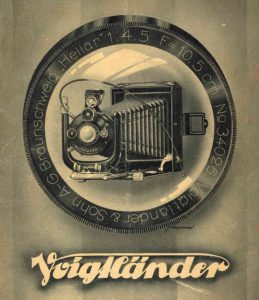
Voigtländer is the world’s oldest optics company, with a history dating back to the 1700s. I spent an unnecessarily large amount of time covering their history in my review for the Vito II so rather than repeat a large amount of that information here, I encourage you to read the first part of the Vito review if you want to know more. For this review, I’ll skip to the beginning of the 20th Century when Voigtländer showed significant interest in building their own cameras, rather than just primarily being a lens maker.
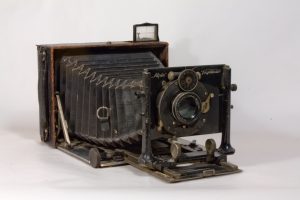
As film photography would gain momentum in the 1900s with models from the Eastman Kodak company and other German makers, Voigtländer started to make a more serious effort into designing their own cameras. In the first two decades of the 20th century, the company would release a wide range of folding plate cameras with names such as Scheren-Camera, Alpin, Stereophotoskop, and Avus.
Voigtländer had great success around this time as both a maker of fine plate cameras and lenses. In 1915, the company would outgrow it’s original factory in Braunschweig and would move to a larger facility on the other side of the town. As Voigtländer gained experience making cameras, they would experiment with a few other designs, such as Single Lens Reflex cameras, and at least one other kind of roll film camera. Collectiblend makes mention of models called the Film Cameras I, II, and III, which appear to be a roll film design, but it doesn’t look like they were in production for very long, and they appear to be very rare so I have to conclude that the roll film design was not a priority for the company in these years.
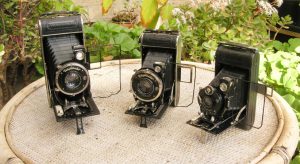
Perhaps due to pressure from it’s customers, or the success of other roll film cameras by Kodak, Zeiss, and other makers, in 1927, Voigtländer would release a series of roll film cameras simply named the Voigtländer Rollfilmkamera or simply “Rollfilm” in English. I could not find a lot of information about these models, but as best as I could tell, the Rollfilm was marketed as an entry level model in Voigtländer’s lineup. It was available in 3 (possibly 4) different sizes, the smallest used 129 format film and took 5cm x 8cm images, the largest used 116 format film and took 6.5cm x 11cm images, and finally, the model being reviewed here used 120 format film and took 6cm x 9cm images. I found mention on one site that there was a 4th size that used 122 format roll film and took monster 8cm x 14cm images, but I have found no evidence that a camera this large existed. Any size Rollfilm could be equipped with 3 different lenses, an f/6.3 Voigtar, a 4-element f/4.5 Skopar, and a 5-element f/4.5 Heliar. Shutters ranged from the basic 3-speed Embezet, all the way to the rim-set Compur.
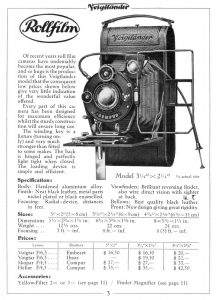
At least one site suggests that over 100,000 Rollfilms were sold, but I cannot validate whether that number is specific to one size of camera or the entire family of them. Whatever the real number is, my guess is the Rollfilm sold reasonably well, as evidenced by the frequent release of new roll film models shortly after it’s release. Within the next 5 years, Voigtländer would release several other roll film models called the Inos, Avus, Beatrix, Jubilar, and the Bessa. From the 1930s and on, Voigtländer would enjoy a reputation as a maker of quality lenses and cameras, with models like the Bessa, Vito, Prominent, and Vitessa being their best sellers.
The model being reviewed here has serial number 282982 on the lens, which this site suggests it was made in 1927, the same year this model was released. It has the 3-element Voigtar lens and Embezet shutter which suggests it was an entry level model. The catalog page to the left from a late 1920s catalog for the Columbia Supply Company in Washington DC suggests that a Rollfilm with the f/6.3 Voigtar and Embezet shutter cost $20, which when adjusted for inflation, is around $275 in 2016.
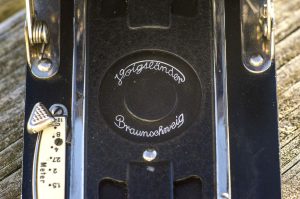
Today, Voigtländer cameras are generally highly regarded like most other German models. The particular Rollfilm camera being reviewed here is a rather obscure model that might interest Voigtländer collectors, or anyone who enjoys pre-war German cameras, but I don’t know that anyone specifically looks for this one. I had never heard of it before stumbling upon it one day on eBay. The value of this camera would vary greatly depending on it’s condition, and what lens and shutter combination it came with. Mine having the more basic Voigtar lens meant it was a pretty inexpensive camera.
My Thoughts
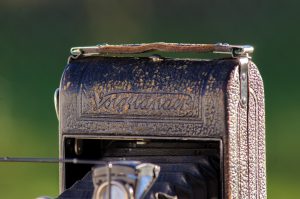
I picked up this camera in early 2016, but never found the right moment to shoot with it. I got it in a lot of other cameras and I remember it being in quite good condition. It actually had a very old roll of Verichrome still in it. The film had to have been at least 50 years old and although I know it can be exciting to develop old film, there’s often a huge risk due to the age of the film requiring it to be sent to someone who specializes in “rescuing” very old film, such as the Rescued Film Project. Not only is sending film to a place like this expensive, but there is a huge risk that there won’t be any images to be rescued. When it sits in the camera as long as it likely did with this Voigtländer, you have no idea how it was stored, whether or not someone had opened the back mid-roll exposing the film, or if even the perils of time left anything to rescue at all.
I made the decision to just roll up the film and keep it as a display piece. Sure, there’s always that “what if” of what could be on those images. Maybe I am in possession of proof of alien life, or who killed Kennedy, but that’s pretty unlikely. Maybe I’ll send it in one day, but not now.
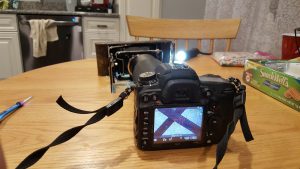
Once an opportunity came around to using this camera, I wanted to check it’s condition to make sure it was capable of making good images. The shutter seemed to work correctly, but a really common problem with old folding cameras is that the camera may have been dropped at some point, or the front lens standard may be bent or otherwise out of position, causing the lens to not focus the image correctly on the focal plane. At the time I was checking this camera, I was also checking another folding camera, my Zeiss-Ikon Icarette 515/6 so I collimated both at the same time. The photo to the right is an image of that Zeiss being collimated, but the process was identical on this Voigtländer.
I wont go into the specifics of how to collimate a camera, or why it works, as I already covered it in my article Breathing New Life into Old Cameras. Follow the link for more info, but in a nutshell, by placing a clear piece of ground glass with an X on it in place of the focal plane of the camera, and then using another camera with known good focus, you can confirm that the focus of the folding camera is accurate by pointing both cameras at once another at infinity and opening both shutters at the same time. Look at the image of the LCD screen on the DSLR to the right. If infinity is correct on the folding camera, those black marks will be very sharp. If the focus is off, the X will be blurry. Thankfully, the focus on the Voigtländer was perfect and it required no adjustment.
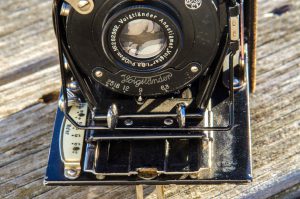
All was not well with the glass elements in the lens however. I took the glass elements out of the camera, and I could see that there was a cemented pair of elements, and in between those two elements appeared to be some haze. Since it is very difficult to separate cemented pairs, I left it alone. I was able to get the rest of the glass surfaces clean, but this camera will have a slight amount of haze in it’s images. As a result, I would need to use a film that already had a very high amount of contrast to somewhat diminish the effect of the haze. For this, I chose a roll of fresh Ilford Delta 100.
While the haze was a bummer, I had to remind myself that this is a camera that is nearly 90 years old and there are many cameras far younger than 90 years that can have haze, fungus, or any other number of lens anomalies. The rest of the camera was in extremely good condition, and who knows, maybe the haze wouldn’t be as bad on the final images, or perhaps even the haze might give a the images a “dreamy” look that could actually enhance the images.
Using the Camera
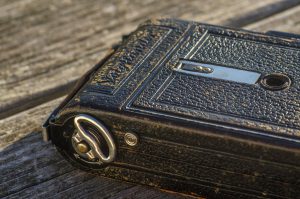
Using the Voigtländer Rollfilm is consistent with pretty much any other early 20th century folding camera. The camera is not a self erecting design. To open the front of the camera, you must push down on a little button on the side, right next to the wind knob. Although the front door will “pop” out a bit, you’ll have to help it out to the fully open position. After opening the door, you must manually pull the front lens standard out by gripping the two “tongs” immediately below the front lens and slide it out as far as it will go. Whenever you are manually opening a folding camera, it is important that you pull on it slowly. For one, you want to minimize any chance that the bellows are stuck which could damage them, but also, if film is already installed into the camera, pulling out the lens standard too fast creates a “vacuum” in the film chamber which could distort or damage the film.
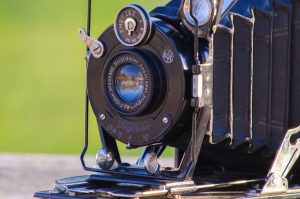
All of the controls for the camera are easily reachable from the front of the camera. The Embezet shutter on this camera is an earlier “dial set” design with the shutter speeds on a small dial above the taking lens, compared to later “rim set” designs where the shutter speeds are changed by a ring that encircles the entire perimeter of the shutter.
The aperture is changed from f/6.3 to f/32 using the lever at the bottom of the shutter.
Finally, the shutter release is the nickel plated lever to the left of the speed selector dial.
To compose your image, you can either use the brilliant finder that is attached to the top right corner of the shutter, or the wire frame “sports finder” on the side of the camera. Brilliant finders on many folding cameras are often very hard to use as the reflective mirror surface has faded or fallen off but thankfully this one was in good shape.
The flip up “sports finder” uses a combination of the wire frame finder around the shutter, and the flip up metal frame on the side of the camera. To use the sports finder, you flip both into their ‘up’ positon, and then position your eye near the smaller metal frame and look through it and whatever is inside of the wire frame will be approximately what would be captured on film. It’s not perfect, but neither is the brilliant finder. I think this aspect of using folding cameras is perhaps the most difficult for a novice. There is a certain amount of guesswork when composing your images.
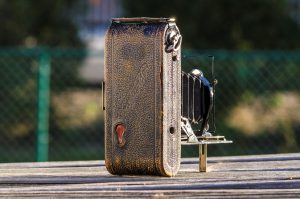
The back of the camera has a red window which allows you to see the frame numbers as you advance the film. Back in the late 1920s when this camera was made, there was no such thing as double exposure prevention, so you must take care to advance the film to the next frame after each and every exposure so as not to double expose the same piece of film.
It’s worth noting that on many old folders, this red window can become faded or damaged over time, allowing light to enter the film compartment, which can cause light leaks on your film. Although mine appeared to be in good condition, care should be taken to not allow direct sunlight to fall on the red window. Film was much slower when these cameras were made, so extra caution must be taken when using modern films which are much more sensitive to light. An additional layer of tape or a layer of rubylith over the red window is not a bad idea, but definitely do not let direct sunlight hit this window or you will streak your film.
My Results
In the highly likely event you did not read this whole review and just jumped straight here to see the results, I’ll recap that this camera was in mostly excellent shape with the one condition issue being some haze in between two cemented elements within the lens which I was not able to clean.
As a result, I chose Ilford Delta 100 film as is known to have good contrast which I thought could help counteract the softness that might be caused by the haze. I shot the entire roll on a trip near Turkey Run State Park in west-central Indiana on a nice late September day. This area of the country is known for excellent hiking trails, creeks, and many covered bridges. The day I shot the Voigtländer, I took with me several other cameras to compare it to.
First, I want to say special thanks to Adam at Quirky Guy Photo Labs™ in Frederick, MD as this was the first roll of film developed at their lab. Adam’s assistant Alex made sure that the development times were spot on, and I must say I am impressed as I haven’t consistently gotten back good B&W scans from other labs.
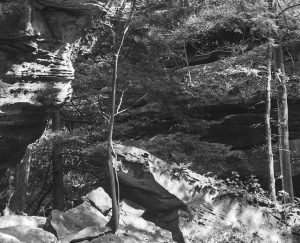
Looking at these images, it is clear the camera is working exactly as it should. I shot everything at the shutter’s top speed of 1/100, and I’d say exposure is spot on. There seems to be a perfectly even balance between the dark corners of the rocks and the brightly lit leaves of the trees. I was very impressed that there’s no evidence of the haze that I saw in the inner element of the lens when I was cleaning it. Either it wasn’t nearly as bad as I had thought, or the Ilford film did exactly what I had hoped and minimized it to a point where it wasn’t even noticeable. Perhaps the most amazing is the sharpness that this camera produced. When I told Adam that this was an f/6.3 triplet, he was pretty impressed that it was able to deliver such sharp results. While other Rollfilms were equipped with better Skopar or Heliar f/4.5 lenses, I wonder how much of an improvement there really would have been.
I’ve recently written reviews on some pretty basic box cameras, and I’ve posted folding camera images before, and it always impresses me how good cameras already were during these early years of photography. If there’s a reason not to shoot with a vintage folder like this Voigtländer Rollfilm, it’s definitely not because of the images they can make. Of course condition is key, and this is where I was very fortunate as this example came to me in excellent shape. Aside from a gentle cleaning, there was nothing I needed to do with it. The focus was accurate, the shutter worked properly, and the lenses were clean enough to produce the images above. Seeing what this Rollfilm was able to do with B&W Ilford, I definitely see a roll or two of color going through this camera someday.
My Final WordHow these ratings work |
The Voigtländer Rollfilm is one of Voigtländer’s earliest attempts at a roll film camera. This particular model was on the lower end of the line as it features the basic Voigtar lens and 3 speed Embezet shutter. Despite it’s modest specs on paper, it is clear that condition plays a much more significant role in the capabilities of the camera. I figured the camera would produce acceptable images, but what I got were perfectly exposed sharp images with little hint at any type of vignetting or distortion. Voigtländer Rollfilms likely won’t come up for sale often, so it would be hard to recommend this model to someone, but if one ever does show up for sale, I can wholeheartedly say this is a well built camera worthy of addition to any collection. | ||||||
| Images | Handling | Features | Viewfinder | Feel & Beauty | History | Age | |
| 2 | 1 | 1 | 0 | 2 | 0 | 40% | |
| Bonus | none | ||||||
| Final Score | 8.4 | ||||||
Additional Resources
http://www.schoebels-voigtlaender-archiv.de/BildRoll.html
http://www.collection-appareils.fr/x/html/camera-1305-Voigtlander.html
http://camerapedia.wikia.com/wiki/Voigtl%C3%A4nder_Rollfilm
http://voigtlander.pagesperso-orange.fr/anglais/rollfilmtousA.htm

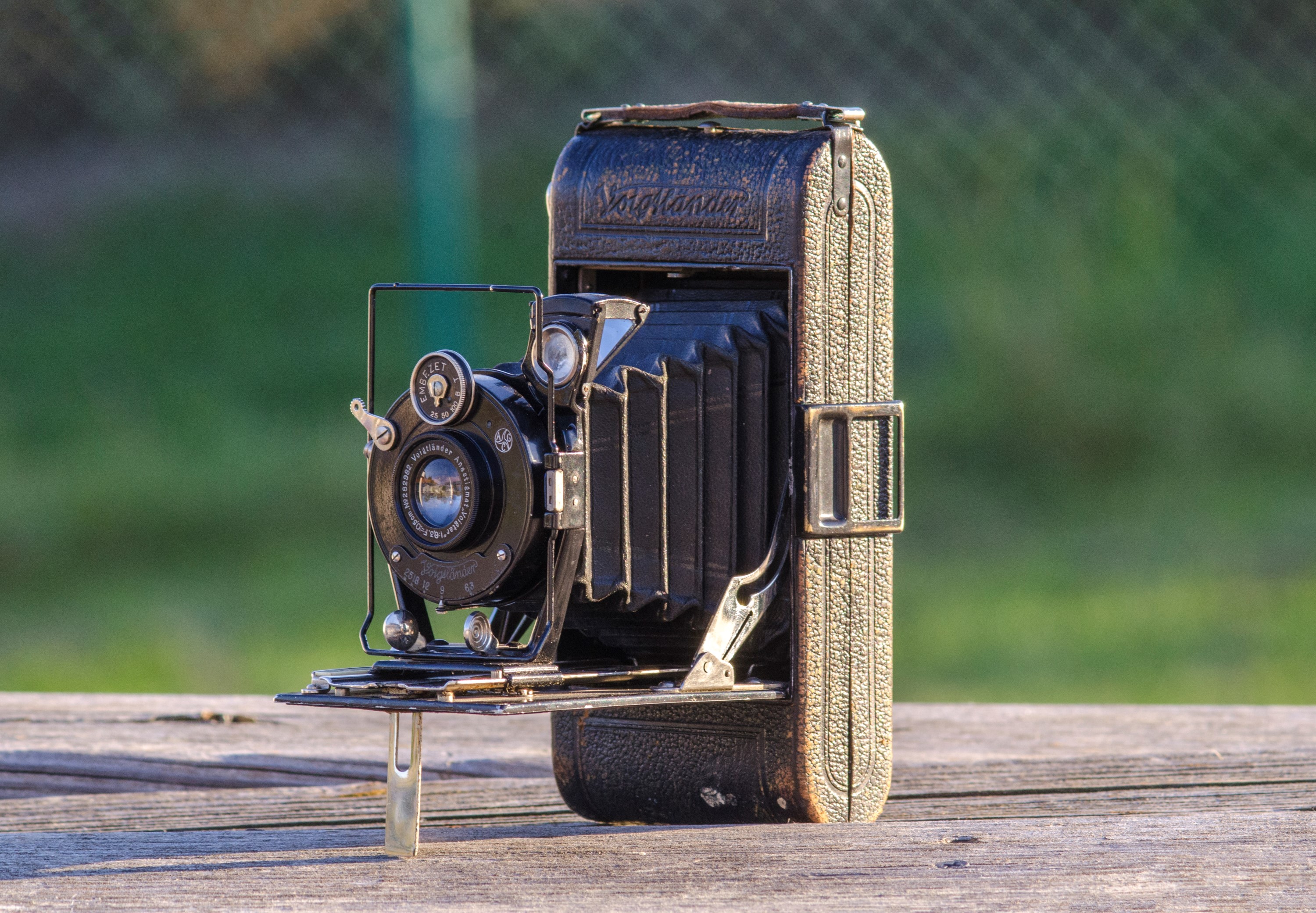
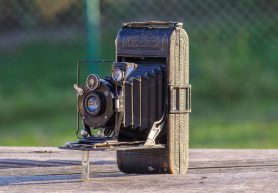
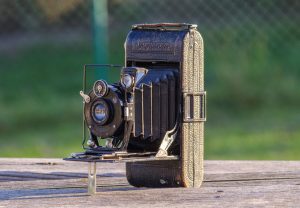






Did you use 120 film in this camera? I found an old model that looks just like yours, but it does not appear that 120 film works, the film roll being too small to stretch from one side to the other of film chambers and attach in the stub ends.
Thanks.
Mark
If 120 film is too small for your camera, its likely your camera was designed for 116 film, which was a very common type of film back then. You can still use 120 film in cameras designed for 116, but you’ll need to make an adapter. I talk about how to do this in my review for my No.1A Pocket Kodak. Check out that review for ideas on how you might be able to do that on yours. If making an adapter isn’t something you want to try, you can keep an eye on eBay as 116 film does occasionally show up. I show a roll of Verichrome 116 that expired in 1977 and the images still came out great, so it is still possible to do it.
Thanks Mike. I will look at that and see if I can do something similar just to try it out for fun.
Mark
This older review was helpful. I just brought home from my office two Voigtlander folders I bought in 2000. A 116 circa 1933 and a 120 circa 1945-35. Both have the Compur shutter and Skopar lense with light tight bellows and clean leather covers. I already know of 116-120 spacers that can be found on eBay. Knew about the spacing as I rolled an older 120 roll through the 116 to determine spacing. The only thing that concerned me was the 116 film gate being wider than 120 film and would the film lie flat. I wondered about making a thin shelf for each edge but then it looks like you didn’t worry about it. Same goes for my 1.A Pocket Kodak.
Very nice review! Your results are extremely impressive. I just picked up one of these cameras in 129 size (5×8), and am waiting for some 127-to-129 adapters to come in right now to give it a try. It’s really wonderful to see others putting these old cameras to use!
Voigtlander made nice cameras, regardless of film size. 129 was a tad bit bigger than 127 I believe so if you can find an adapter, 127 would work really well. I am actually in the works of putting together a 129 film camera review sometime this year. Stay tuned! 🙂
Great review! I just got a late Rollfilm with a Heliar on a Compur shutter. One thing I like is the focusing mechanism, with the lever and the scale on the side, and the infinity lock. The fact that the camera focuses the lens as a unit is an added advantage, when compared to Bessas.
Mike, do you know where I might find a wind knob or a substitute for this camera? I have one that works, but for not having a winding knob and a safety pin is a poor substitute.
Thanks
Mark, I am sorry, but other than finding a spare body that you can take that part from, finding an exact replacement is not likely to be easy. I guess if you were good at 3D printing, one could be made up, but it wouldn’t look like the original.